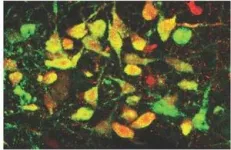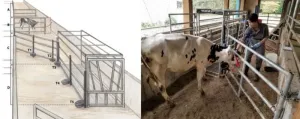(Press-News.org) Our nervous systems are naturally wired to sense fear. Whether prompted by the eerie noises we hear alone in the dark or the approaching growl of a threatening animal, our fear response is a survival mechanism that tells us to remain alert and avoid dangerous situations.
But if fear arises in the absence of tangible threats, it can be harmful to our well-being. Those who have suffered episodes of severe or life-threatening stress can later experience intense feelings of fear, even during situations that lack a real threat. Experiencing this generalization of fear is psychologically damaging and can result in debilitating long-term mental health conditions such as post-traumatic stress disorder (PTSD).
The stress-induced mechanisms that cause our brain to produce feelings of fear in the absence of threats have been mostly a mystery. Now, neurobiologists at the University of California San Diego have identified the changes in brain biochemistry and mapped the neural circuitry that cause such a generalized fear experience. Their research, published in the journal Science on March 15, 2024, provides new insights into how fear responses could be prevented.
In their report, former UC San Diego Assistant Project Scientist Hui-quan Li, (now a senior scientist at Neurocrine Biosciences), Atkinson Family Distinguished Professor Nick Spitzer of the School of Biological Sciences and their colleagues describe the research behind their discovery of the neurotransmitters — the chemical messengers that allow the brain’s neurons to communicate with one another — at the root of stress-induced generalized fear.
Studying the brains of mice in an area known as the dorsal raphe (located in the brainstem), the researchers found that acute stress induced a switch in the chemical signals in the neurons, flipping from excitatory “glutamate” to inhibitory “GABA” neurotransmitters, which led to generalized fear responses.
“Our results provide important insights into the mechanisms involved in fear generalization,” said Spitzer, a member of UC San Diego’s Department of Neurobiology and Kavli Institute for Brain and Mind. “The benefit of understanding these processes at this level of molecular detail — what is going on and where it’s going on — allows an intervention that is specific to the mechanism that drives related disorders.”
Building upon this new finding of a stress-induced switch in neurotransmitters, considered a form of brain plasticity, the researchers then examined the postmortem human brains of individuals who had suffered from PTSD. A similar glutamate-to-GABA neurotransmitter switch was confirmed in their brains as well.
The researchers next found a way to stop the production of generalized fear. Prior to the experience of acute stress, they injected the dorsal raphe of the mice with an adeno-associated virus (AAV) to suppress the gene responsible for synthesis of GABA. This method prevented the mice from acquiring generalized fear.
Further, when mice were treated with the antidepressant fluoxetine (branded as Prozac) immediately after a stressful event, the transmitter switch and subsequent onset of generalized fear were prevented.
Not only did the researchers identify the location of the neurons that switched their transmitter, but they demonstrated the connections of these neurons to the central amygdala and lateral hypothalamus, brain regions that were previously linked to the generation of other fear responses.
“Now that we have a handle on the core of the mechanism by which stress-induced fear happens and the circuitry that implements this fear, interventions can be targeted and specific,” said Spitzer.
END
How fear unfolds inside our brains
Neurobiologists uncover how stress turns into fear in the brain — in conditions such as PTSD — and a method to block it
2024-03-14
ELSE PRESS RELEASES FROM THIS DATE:
A new world of 2D material is opening up
2024-03-14
Materials that are incredibly thin, only a few atoms thick, exhibit unique properties that make them appealing for energy storage, catalysis and water purification. Researchers at Linköping University, Sweden, have now developed a method that enables the synthesis of hundreds of new 2D materials. Their study has been published in the journal Science.
Since the discovery of graphene, the field of research in extremely thin materials, so-called 2D materials, has increased exponentially. The reason is that 2D materials have a large surface area in relation to their volume or weight. This ...
Discovered: Cellulose-degrading gut bacteria in the human gut, although at lower levels in industrialized countries
2024-03-14
Previously undescribed human gut bacteria that aid in the digestion of plant cellulose are scarce in urban societies but abundant in ancient and hunter-gatherer microbiomes, according to a new study. The findings provide insight into the poorly understood cellulosome-producing bacteria that inhabit the human gut and their response to modern urban diets and lifestyles. Like all mammals, humans rely on the gut microbiome to digest cellulose – the main component of plant fiber and a common element in diets that include plant-based material. Fermentation of dietary fiber via cellulosome-producing ...
Direct-to-consumer microbiome testing lacks regulation and clinical validity
2024-03-14
In a Policy Forum, Diane Hoffman and colleagues argue that direct-to-consumer (DTC) microbiome tests lack analytical and clinical validity and require more federal regulation to prevent consumer harm. A growing body of research has suggested the potential for improving human health by better understanding the microbiome, leading to the emergence of a global industry selling DTC microbiome services. However, despite its impact on the lifestyle health and wellness market, regulation of the DTC microbiome testing industry has been virtually ignored. According to Hoffman et al., these companies’ claims of having ...
New approach to plastic production, under more sustainable conditions
2024-03-14
Researchers have developed a more sustainable method to do the work required to make plastics that are comparable to widely used low-density polyethylene (LDPE) plastics. They say their method is industrially viable. LDPE is a soft, flexible, and lightweight plastic material that is widely used in a variety of commercial applications, including plastic films, bottles and other pliable products. LDPE’s unique properties are derived from its tree-branch-like molecular structure, bestowing flexibility. The material is also ductile due to its lower crystallinity. These properties set it apart from other, more linear varieties of polyethylene. ...
A telluride-free way to improve the performance of thermoelectric systems
2024-03-14
Researchers report they have boosted the performance of a thermoelectric device using an approach that doesn’t require tellurium. The findings reveal a path toward more efficient and sustainable commercial applications of thermoelectric cooling based on Earth-abundant compounds. Efficient and sustainable cooling is crucial to modern living, particularly in our warming world. However, current cooling strategies require substantial energy, which can exacerbate anthropogenic climate impacts. Thermoelectric cooling is an attractive solid-state heat-pump technology that could reduce energy consumption ...
University of Maryland, Baltimore researchers call for regulation of direct-to-consumer microbiome tests
2024-03-14
BALTIMORE, March 14, 2024: Scientific research has linked a person’s microbiome to everything from gut and mental health to immunity and predisposition to cancer. This research comes at a time when there is a burgeoning interest in wellness and alternative medicine, which has fueled consumers’ curiosity about the composition of their own microbiomes.
This curiosity has led to a growing demand for direct-to-consumer (DTC) microbiome testing services. While the companies marketing these services claim to tell customers whether their microbiomes (gut, vaginal, skin…) are “healthy,” ...
Training dairy cows with positive reinforcement can turn otherwise stressful events into play
2024-03-14
Philadelphia, March 14, 2024 – Dairy cows receive a huge amount of care during their lives on a farm, but procedures, especially restraining during procedures, can be stressful for some animals. Positive reinforcement training—or training with a reward to achieve a desired behavior—has shown promise to reduce this fear in other species. In a recent study in the Journal of Dairy Science, published by the American Dairy Science Association and Elsevier, a team of researchers set out to understand whether ...
Information overload is a personal and societal danger
2024-03-14
We are all aware of the dangers of pollution to our air, water, and earth. In a letter recently published in Nature Human Behavior, scientists are advocating for the recognition and mitigation of another type of environmental pollution that poses equivalent personal and societal dangers: information overload.
With the internet at our fingertips with smartphones, we are exposed to an unprecedented amount of data far beyond our ability to process. The result is an inability to evaluate information and make decisions. Further, it can lead us to limit our social activities, feel unsatisfied with ...
Study: How home food availability affects young children’s nutrient intake
2024-03-14
URBANA, Ill. – Early childhood is an important time for learning about nutrition and establishing healthy eating behaviors. Young children rely on parents to provide food options, and the availability of food in the home affects their dietary choices. A new study from the University of Illinois Urbana-Champaign looks at changes in home food availability and nutrient intake for children from 2 to 4 years old.
“It's important to understand how the environments that children are in can influence their diet and nutrition. What types of foods and beverages are available in the home, and how accessible ...
A pioneering way to target the culprit behind a deadly liver cancer
2024-03-14
Cell division is the generative spark of nearly every lifeform on Earth. But if healthy growth goes unchecked, cell division can turn lethal, overwhelming the organism. Such is the case with so-called oncogenes. When altered by a mutation, these growth-moderating genes go haywire, producing a geyser of cancer cells as a result. Oncogenes are also insidiously adept at generating tumors that over time become genetically “independent” from their origin, so it has been exceedingly difficult for scientists to shut down their replication ...
LAST 30 PRESS RELEASES:
Making lighter work of calculating fluid and heat flow
Normalizing blood sugar can halve heart attack risk
Lowering blood sugar cuts heart attack risk in people with prediabetes
Study links genetic variants to risk of blinding eye disease in premature infants
Non-opioid ‘pain sponge’ therapy halts cartilage degeneration and relieves chronic pain
AI can pick up cultural values by mimicking how kids learn
China’s ecological redlines offer fast track to 30 x 30 global conservation goal
Invisible indoor threats: emerging household contaminants and their growing risks to human health
Adding antibody treatment to chemo boosts outcomes for children with rare cancer
Germline pathogenic variants among women without a history of breast cancer
Tanning beds triple melanoma risk, potentially causing broad DNA damage
Unique bond identified as key to viral infection speed
Indoor tanning makes youthful skin much older on a genetic level
Mouse model sheds new light on the causes and potential solutions to human GI problems linked to muscular dystrophy
The Journal of Nuclear Medicine ahead-of-print tip sheet: December 12, 2025
Smarter tools for peering into the microscopic world
Applications open for funding to conduct research in the Kinsey Institute archives
Global measure underestimates the severity of food insecurity
Child survivors of critical illness are missing out on timely follow up care
Risk-based vs annual breast cancer screening / the WISDOM randomized clinical trial
University of Toronto launches Electric Vehicle Innovation Ontario to accelerate advanced EV technologies and build Canada’s innovation advantage
Early relapse predicts poor outcomes in aggressive blood cancer
American College of Lifestyle Medicine applauds two CMS models aligned with lifestyle medicine practice and reimbursement
Clinical trial finds cannabis use not a barrier to quitting nicotine vaping
Supplemental nutrition assistance program policies and food insecurity
Switching immune cells to “night mode” could limit damage after a heart attack, study suggests
URI-based Global RIghts Project report spotlights continued troubling trends in worldwide inhumane treatment
Neutrophils are less aggressive at night, explaining why nighttime heart attacks cause less damage than daytime events
Menopausal hormone therapy may not pose breast cancer risk for women with BRCA mutations
Mobile health tool may improve quality of life for adolescent and young adult breast cancer survivors
[Press-News.org] How fear unfolds inside our brainsNeurobiologists uncover how stress turns into fear in the brain — in conditions such as PTSD — and a method to block it





